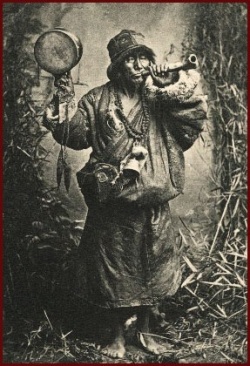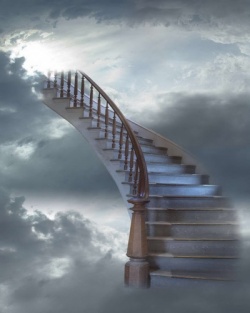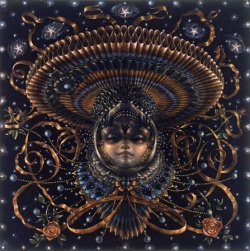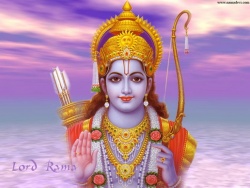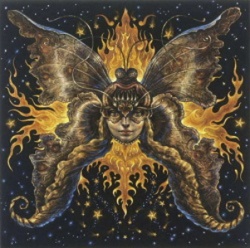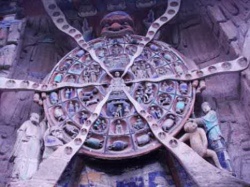Chakravartin
Click here to see other articles relating to word Chakravartin
- See also :
- See also :
Chakravartin (चक्रवर्तिन् cakravartin, Pali Cakkavatti), is a term used in Indian religions for an ideal universal ruler, who rules ethically and benevolently over the entire world. Such a ruler's reign is called sarvabhauma. It is a bahuvrīhi, literally meaning "whose wheels are moving", in the sense of "whose chariot is rolling everywhere without obstruction". It can also be analyzed as an 'instrumental bahuvrīhi: "through whom the wheel is moving" in the meaning of "through whom the Dharmacakra ("Wheel of the Dharma) is turning" (most commonly used in Buddhism and Hinduism).
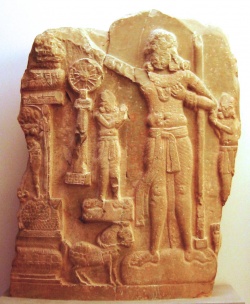
In Buddhism and Jainism, three types of Chakravartins are distinguished:
- Cakravala Cakravartin: a ruler over all four continents postulated in ancient Indian cosmography
- Dvipa Cakravartin: a ruler over only one of four continents
- Pradesa Cakravartin: a ruler over only part of a continent.
The first references to a cakravala cakravartin appear in monuments from the time of the Maurya Empire (322–185 BCE), dedicated to Chandragupta Maurya and his grandson Ashoka Maurya. It has not been generally used for any other historic figure. The cakravartin in Buddhism came to be considered the secular counterpart of a Buddha. In the Majjhima Nikaya, Gautama Buddha is quoted as stating that a woman can never be(come) a chakravartin. Bhikkhuni Heng-Ching Shih states referring to women in Buddhism: "Women are said to have five obstacles, namely being incapable of becoming a Brahma King, 'Sakra', King 'Mara', Cakravartin or Buddha."
In general, the term applies to temporal as well as spiritual kingship and leadership, particularly in Buddhism and Jainism. In Hinduism, the term generally denotes a powerful ruler, whose dominion extended to the entire earth.
Maitrayaniya Upanishad
The Maitrayaniya Upanishad (1.5) uses the term for kings who had renounced their royal prerogatives in favour of asceticism.
अथ किमेतैर्वा परेऽन्ये महाधनुर्धराश्चक्रवर्तिनः
केचित्सुद्युम्नभूरिद्युम्नेन्द्रद्युम्नकुवलयाश्वयौवनाश्ववद्धिया
श्वाश्वपतिः शशबिन्दुर्हारिश्चन्द्रोऽम्बरीषो
ननूक्तस्वयातिर्ययातिनरण्योक्षसेनोत्थमरुत्तभरतप्रभृतयो
राजानो मिषतो बन्धुवर्गस्य महतीं श्रियं
त्यक्त्वास्माल्लोकादमुं लोकं प्रयान्ति .. ५.
atha kimetairvā pare'nye mahādhanurdharāścakravartinaḥ
kecitsudyumnabhūridyumnendradyumnakuvalayāśvayauvanāśvavaddhiyā
śvāśvapatiḥ śaśabindurhāriścandro'mbarīṣo
nanūktasvayātiryayātinaraṇyokṣasenotthamaruttabharataprabhṛtayo
rājāno miṣato bandhuvargasya mahatīṁ śriyaṁ
tyaktvāsmāllokādamuṁ lokaṁ prayānti
Mahabharata
In the Mahabharata, twelve princes beginning with Bharata are considered Chakravartins.
- Ikshvaku, the son of Ila of the Suryavanshi lineage after whom India was named as Ilavarta and Eelam. In Hindu mythology he is said to have conquered the world.
- Bharat was the son of the Puru Dynasty. The official name of the Republic of India, Bhārat (भारत) in Hindi and Bhāratam (भारतम्) in Sanskrit is named after him. He was able to conquer the whole Indian subcontinent. Legend holds that he even conquered regions outside of the Subcontinent such as Afghanistan (then referred to as Gandhara) and Tibet (then referred to as Bhūta).
- Shibi, famous in Hindu and Buddhist mythology. He sacrificed his flesh. There have been several dynasties which have claimed heritage from Emperor Shibi's line. The Cholas were one of the dynasties and they referred to him as Sembiyan.
- Imayavaramban Neduncheralathan, a Sangam age king said in inscriptions to have conquered up to the Himalayas.
Jainism
During the each motion of the half-cycle of the wheel of time, 63 Śalākāpuruṣa or 63 illustrious men, consisting of the 24 Tīrthaṅkaras and their contemporaries regularly appear.[8] The Jain universal or legendary history is basically a compilation of the deeds of these illustrious men. As per Jain cosmology, out of these 63, twelve are Chakravartins, who are Universal Monarch or World Conquerors. The Jaina Puranas give a list of twelve such Cakravartins who flourished in this Avasarpini. Golden in complexion, they all belonged to the Kasyapa gotra. The mother of a Cakravartin sees some dreams at the time of conception. According to the Adipurana, Bharata's mother saw the sun and the moon, the mount Meru, the lake with swans, earth and the ocean. According to Acharya Hemachandra, Marudevi, mother of Bharata, sees fourteen great dreams. A chakravartin is considered an ideal human being endowed with thirty-two major signs of excellence and many minor signs of excellence.
The list of 12 Chakravartins as per Jainism is as follows:
- Bharata, son of Tirthankara Rishabha
- Sagara, ancestor of Bhagiratha as in the Puranas
- Maghavan
- Sanatkumara
- Tirthankara Shantinath
- Tirthankara Kunthunath
- Tirthankara Aranath
- Subhauma
- Padmanabha
- Harishena
- Jayasena
- Brahmadatt
In Jainism, a chakravartin was characterized by possession of saptaratna, or "seven jewels":
Some lists cite navaratna or "nine jewels" instead, adding "prime minister" and "son".
Important quotes
- “Buddhist and Jain literatures describe their enlightened founders (the Buddha or Buddhas and the tīrthaṅkaras, respectively) in similar terms, the notion being that religious truth transcends local or national limitations and applies to all people everywhere. This idea is particularly evident in Buddhist oral and scriptural traditions, which frequently refer to Gautama as a cakravāla cakravartin, an illuminator of dharma (life in adherence to compassionate truth) in all regions of the world.”
- from bookrags.com
- “What do you think, Subhuti, is the Tathagata to be seen by means of his possession of marks? -Subhuti replied: No indeed, O Lord. -The Lord said: If, Subhuti, the Tathagata could be recognized by his possession of marks, then also the universal monarch would be a Tathagata.”
- from Buddhist Wisdom Books, The Diamond Sutra and the Heart Sutra, translated and explained by Edward Conze
- “"What do you think Subhuti? Can someone meditate on the Tathagata by means of the thirty-two marks? Subhuti said, "Yes, World-Honored One. We should use the thirty-two marks to meditate on the Tataghata." The Buddha said, "If you say that you can use the thirty-two marks to see the Tathagata, then the Cakravartin is also a Tathagata?" Subhuti said, "World-Honored One, I understand your teaching. One should not use the thirty-two marks to meditate on the Tathagata."
- from The Diamond That Cuts Through Illusion, commentaries on the Prajñaparamita Diamond Sutra, Thich Nhat Hanh
- “Monks, I don't envision any other single strength so hard to overcome as this: the strength of Mara. 3 And the adopting of skillful qualities is what causes this merit to increase.”
- from Cakkavatti Sutta
Source
chakravartin 転輪聖王 (Skt; Jpn tenrin-jo’o )
Also, chakravarti-raja.Wheel-turning king or wheel-turning sage king.Ideal rulers in Indian mythology.The Sanskrit word chakra means wheel, and vartin, one who turns.The chakravartin indicates one who, turning a wheel bestowed by heaven, advances anywhere at will to establish peace and rule the world with justice rather than with force.
See also; chakra; wheel-turning king.
